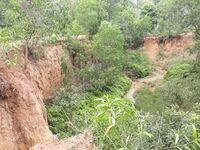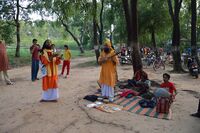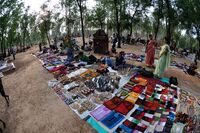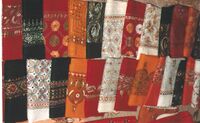شانتينيكتان
شانتينيكتان
শান্তিনিকেতন Santiniketan | |
|---|---|
Neighbourhood | |
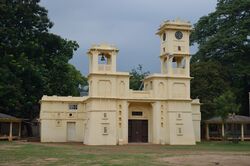 Sinha Sadan | |
| الإحداثيات: 23°41′N 87°41′E / 23.68°N 87.68°E | |
| البلد | India |
| الولاية | البنغال الغربية |
| الضلع | بيربهوم |
| المحكومة | بولپور |
| المنسوب | 30 m (100 ft) |
| اللغات | |
| • Official | البنغالية، الإنگليزية |
| منطقة التوقيت | UTC+5:30 (IST) |
| PIN | 731204 (Bolpur) 731235 (Santiniketan) 731236 (Sriniketan) |
| Telephone/STD code | +91 03463 |
| دائرة لوك سابها | بولپور |
| Vidhan Sabha constituency | بولپور |
شانتينيكتان Shantiniketan هي حي في مدينة بولپور في محكومة بولپور في ضلع بيربهوم في البنغال الغربية، الهند، approximately 152 km north of Kolkata. It was established by Maharshi Devendranath Tagore, and later expanded by his son Rabindranath Tagore whose vision became what is now a university town with the creation of Visva-Bharati.[1]
التاريخ
In 1863, Debendranath Tagore took on permanent lease 20 acre (81،000 m2) of land, with two chhatim (alstonia scholaris) trees, at a yearly payment of Rs. 5, from Bhuban Mohan Sinha, the talukdar of Raipur, Birbhum. He built a guest house there and named it Shantiniketan (the abode of peace). Gradually, the whole area came to be known as Shantiniketan.[2]
الجغرافيا

5miles
M: مدينة/بلدة بلدية، CT: بلدة تعداد، R: مركز ريفي/حضري، U: جامعة.
بسبب قيود المساحة في الخريطة الصغيرة، المواقع الفعلية في خريطة أكبر قد تختلف قليلاً
الموقع
تقع شانتينيكتان عند الإحداثيات 23°41′N 87°41′E / 23.68°N 87.68°E.[3] at an average elevation of 56 metres (187 feet).
The area is flanked on two sides by the rivers, the Ajay and the Kopai. Santiniketan earlier had an extensive forest cover, but substantial soil erosion gave certain areas a barren look, the resulting phenomenon is locally known as khoai. However, as a result of the consistent efforts by botanists, plants and trees from all over India flourish in parts of the town. Although the overall environment of the surrounding areas have changed with time, the core area of Santiniketan has retained its closeness with nature.[4]
Note: The map alongside presents some of the notable locations in the area. All places marked in the map are linked in the larger full screen map.
In the 2011 census, Santiniketan is not identified as a separate place. In the map of Bolpur-Sriniketan CD block on page 718 of District Census Handbook Birbhum (Part A), the area occupied by Santiniketan is shown as a part of Bolpur municipal area and Sriniketan is shown as a part of Surul, a census town.
أماكن شهيرة
As per the Human Development Report for Birbhum in 2009, Santiniketan attracted 1.2 million tourists annually.[5]
Rabindra Bhavana, founded in 1942, just after the death of the poet, is the focal point of Visva Bharati. It has a museum, archives, library and other units. It houses a major part of Rabindranath's manuscripts, correspondence, paintings and sketches, 40,000 volumes of books and 12,000 volumes of bound journals, photographs and numerous items associated with the poet's life. It is generally one of the first points of interest for anybody visiting Santiniketan.[6] It was established by the poet's son, Rathindranath Tagore, as a memorial museum and research centre for Tagore studies.[7]
The Uttarayana Complex, which lies in the northern portion of the town and is located next to Rabindra Bhavana, features a collection of five houses built by Rabindranath – Udayan, Shyamali, Konark, Udichi and Punascha. The gardens in the Uttarayan complex were planned and laid out by Rathindranath. Shyamali and Konark are mud houses. Shyamali was an experiment. The visual perspective was based on the Borobudur style. The entire outside wall was decorated with beautiful relief work by Kala Bhavana students under the guidance of Nandalal Bose. The Santals on either side of the main door and on the eastern corner were by Ramkinkar Baij. Mahatma Gandhi and Kasturba Gandhi stayed in the house as guests. Udayan is the most imposing house in the Uttarayan complex. It is meant for important guests visiting Santiniketan. Each suite in Udayan is on a different level which gives this house its individuality.[8] In 2013, Visva Bharati opened a museum Guha Ghar, in the Uttarayan complex, in memory of Rathindranath Tagore.[9][10]
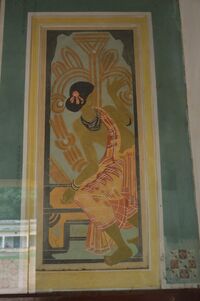
The Ashram Complex is the oldest area of Santiniketan, where Debendranath built the Santiniketan Griha and the beautiful stained glass prayer hall, in the second half of the 19th century. Patha Bhavana came up after Rabindranath started residing in Santiniketan. It has beautiful frescoes by Nandalal Bose. Natun Bari was built in 1902 for residential purposes. Kalo Bari is a unique structure of mud and coal tar and profusely decorated. There are numerous other houses: Dehali, Santoshalaya, Singha Sadan, Dwijaviram, Dinantika, Taladwaj, Chaitya, Ghantatala, Panthasala, Ratan Kuthi, Malancha and others – each with an interesting story that makes it historically relevant.[8]
Visva Bharati was established as a centre for culture with the objective of exploring the arts, language, humanities, music etc. Specialised institutes came up in different fields: Cheena Bhavana, Hindi Bhavana, Kala Bhavana, Sangit Bhavana, Bhasa Bhavana, Nippon Bhavana, Bangladesh Bhavana and others. Many of these institutes with myriad structures have been decorated by illustrious artists.[8]
"The landscape of Shantiniketan is dotted with sculptures by Ramkinkar Baij (1906–1980), larger-than-life figures of Santals who were in reality part of the landscape. A Santal family, complete with dog, a group of workers running along at the call of the mill, their clothes flying in the air, a thresher, all situated along the main road. When Ramkinkar created Sujata, an elongated figure of one of the disciples of Buddha, he placed it just a little distance from the seated Buddha. Nandalal planted Eucalyptus saplings in the area, knowing that one day these tall trees would be a perfect setting to Ramkinkar's Sujata. It was Nandalal Bose, who created an environment where art would be a part of life and the children of Santiniketan have grown absorbing these beautiful monuments as they have the oxygen in the air."[8]
معرض صور
الهامش
- ^ Pearson, WW.: Santiniketan Bolpur School of Rabindranath Tagore, illustrations by Mukul Dey, The Macmillan Company, 1916
- ^ Basak, Tapan Kumar, Rabindranath-Santiniketan-Sriniketan (An Introduction), p. 2, B.B.Publication
- ^ Falling Rain Genomics, Inc - Santiniketan
- ^ "Santiniketan".
- ^ "District Human Development Report: Birbhum, Chapter IV: Economic Opportunities and Security of Livelihood". Page 100: Tourism. Development & Planning Department, Government of West Bengal, 2009. Retrieved 25 July 2019.
- ^ "Visva Bharati". Rabindra Bhavana. Retrieved 25 July 2019.
- ^ "Visva Bharati complex, Ravindra Bhavana". Campus Map. Visva Bharati. Retrieved 3 August 2019.
- ^ أ ب ت ث "Santiniketan" (in الإنجليزية). UNESCO World Heritage Centre.
- ^ "Museum and book in memory of Rathindranath Tagore, son of Rabindranath Tagore". Jagran Josh, 1 July 2013. Retrieved 26 July 2019.
- ^ "Museum for 'unsung' Tagore son". The Telegraph. 1 April 2013. Retrieved 26 July 2019.
للاستزادة
- UNESCO: Santiniketan (on the Tentative List since 2010)
- Places to visit in Santiniketan 2019
وصلات خارجية
 شانتينيكتان travel guide from Wikivoyage with local area map
شانتينيكتان travel guide from Wikivoyage with local area map
- تحويل قالب:سانتينيكتان
- تحويل قالب:ضلع بيربهوم



